Papers by Tran Thanh Men 001974
Journal of Animal Behaviour and Biometeorology, 2022

Asian journal of biology, Nov 26, 2021
The study aimed to evaluate the toxic ability of the ethanol extract of Ricinus communis (L.) in ... more The study aimed to evaluate the toxic ability of the ethanol extract of Ricinus communis (L.) in Drosophila melanogaster fruit fly model. The toxicity was determined through different criteria, including the ability to cause harmful effects on second instar larvae, reproduction, growth and development, and the movement ability of fruit flies. The results showed that the ethanol extract of Ricinus communis expressed its high toxicity against 2 nd instar larvae of Drosophila melanogaste with the LD 50 value of 64.63 mg/mL. In addition, Ricinus communis extract reduced the growth rate, reproduction and decreased the movement ability of Drosophila melanogaster. The total flavonoid and polyphenol content of the ethanol extract of Ricinus communis were 338.26 mgQE/g extract and 160.43 mgGAE/g extract, respectively. These findings contribute to confirming the toxic properties of ethanol extract of Ricinus communis and their potential use in preventing and controlling pest.
Journal of Traditional and Complementary Medicine

The Natural Products Journal
Background: Peperomia pellucida is a medicinal and vegetable plant used worldwide, representing a... more Background: Peperomia pellucida is a medicinal and vegetable plant used worldwide, representing a multi-purpose vegetable with applications in the pharmaceutical, food and cosmetic industries. Objective: This study evaluated the antioxidant, antibacterial, antifungal, anti-inflammatory, and antidiabetic potential of fractional extracts from P. pellucida plant derived from Can Tho City, Vietnam. Methods: Four fractional extracts were prepared using different polarity solvents (hexane, dichloromethane, ethyl acetate) and used to determine the best extract for each biological property. The fractions’ total alkaloid, phenolic, and flavonoid content were observed. The four extracts were evaluated for their potential bioactivities: antioxidant, antibacterial, antifungal, anti-inflammatory, and antidiabetic. Results: Correspond with the hexane, dichloromethane, ethyl acetate, and aqueous fractions, the total content of alkaloids was determined to be 255 ± 23.8; 157 ± 14.0; 219 ± 6.55; 221 ...
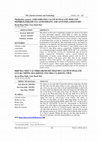
TNU Journal of Science and Technology
Tác dụng của các hợp chất có hoạt tính sinh học trong thực vật được thể hiện dựa trên khả năng ch... more Tác dụng của các hợp chất có hoạt tính sinh học trong thực vật được thể hiện dựa trên khả năng chống oxy hóa, giúp giảm thiểu tác hại gây ra bởi các gốc tự do sinh ra từ quá trình hình thành và phát triển sỏi niệu. Chiết xuất diệp hạ châu chứa một lượng lớn chất chống oxy hóa có thể đóng vai trò quan trọng trong việc hấp phụ và trung hòa các gốc tự do. Hoạt tính chống oxy hóa này phần lớn có thể là do thành phần phenolic và flavonoid có chứa trong thực vật với hàm lượng lần lượt là 438,13±16,37 (mg GAE/g cao chiết) và 157,10±1,31 (mg QE/g cao chiết). Khả năng kháng oxy hóa được đánh giá qua 4 phương pháp DPPH, ABTS, RP, TAC với giá trị EC50 lần lượt là 129,74±3,05; 82,35±1,25; 196,03±6,66 và 40,32±2,78 µg/mL. Cao chiết diệp hạ châu giúp giảm biến tính protein albumin huyết thanh bò với IC50 là 1,52±0,28 mg/mL, thấp hơn 7,24 lần so với chất chuẩn diclofenac (0,21± 0,08 mg/mL). Sự tạo mầm của tinh thể calcium oxalate bị ức chế bởi chiết xuất từ diêp hạ châu với IC50 là 4,74±0,31 mg/mL...
Can Tho University Journal of Science, 2019
Research Highlights in Disease and Health Research Vol. 1
Research Highlights in Disease and Health Research Vol. 1, Feb 7, 2023

Food Science and Technology
Bidens pilosa L. is a species of plant that grows wild. It is commonly found in abundance in the ... more Bidens pilosa L. is a species of plant that grows wild. It is commonly found in abundance in the Mekong Delta region of Vietnam. This study aimed to investigate the chemical composition, in vitro and in vivo antioxidant activity, the antimicrobial activity against some aquatic pathogenic bacteria and antifungal activity against plant pathogenic bacteria of Bidens pilosa L. extract. The results showed that Bidens pilosa L. extract had good antioxidant capacity through all four test methods of DPPH, ABTS •+ , RP, and TAC with the EC 50 values of 455.78 ± 3.28 μg/mL, 148.68 ± 2.02 μg/mL, 462.09 ± 12.57 μg/mL and 139.14 ± 4.34 μg/mL, respectively. Fruit flies fed on a diet supplemented with 0.5 g/mL of Bidens pilosa L. extract had an average lifespan of 2.15 times and 1.54 times longer under oxidative stress using 20 mM Paraquat and H 2 O 2 10%, respectively. In addition, the total polyphenols and total flavonoids in the extract were also determined to be 107.49 ± 4.04 mg GAE/g and 165.63 ± 2.90 mg QE/g, respectively. Regarding the antimicrobial activity, the ethanol extract of Bidens pilosa L. showed stronger resistance to Gram (+) S. agalactiae than the tested Gram (-) bacteria, including A. hydrophila, E. ictaluri, and A. dhakensis. In addition, the ethanol extract from Bidens pilosa L. also showed the better ability to inhibit the growth of the fungus Colletotrichum sp. (MIC = 1250 µg/mL) than that of Fusarium oxysporum (MIC = 2500 µg/mL).

The purpose of the present study was concerned with the taxonomy and influences of some cultural ... more The purpose of the present study was concerned with the taxonomy and influences of some cultural conditions on growth and antimicrobial metabolite production of a strain of Streptomyces, designated KGG32, which is a highly stable antimicrobial metabolite producer against the Gram-positive and Gram-negative bacteria under in-vitro growth conditions. In order to optimize the culture conditions for the production of antimicrobial metabolite, such as the effect of different temperatures, nature of carbon and nitrogen sources, pH value and time incubation were determined. Effects of nutritional compounds on production of antimicrobial compounds showed that the highest antimicrobial activities were obtained when sucrose at 1.0% (w/v) level was used as sole carbon source, under aerobic conditions at temperature 30 degrees C, pH at 7.5. Bacteriological peptone was identified as nitrogen source that significantly affected antibiotic production followed by meat extract. Phenotypic characters of the strain strongly suggested that this strain belongs to the genus Streptomyces. The strain was grey colored with rectiflexibiles spore chains, exhibited resistance to neomycin, vancomycin and penicillin. It had the ability to produce enzymes such as caseinase amylase and xylanase. The results showed that strain KGG32 was a potential soil microorganism with antimicrobial activity and may be used for biotechnological purposes. (C) 2011 Friends Science Publisher

Veterinary Integrative Sciences
Peperomia pellucida (L.) is commonly used as a herbal plant. Its effectiveness in treating inflam... more Peperomia pellucida (L.) is commonly used as a herbal plant. Its effectiveness in treating inflammatory diseases, digestive disorders, and cancer in tropical and subtropical countries was introduced, especially in field of folk medicine. However, this plant species has not been studied widely in Vietnam, especially for its biological activities. This study was done to determine the antioxidant capacity of P. pellucida by using in vitro and in vivo methods, as well as its inhibitory ability to α-amylase enzyme activity. The total polyphenolic and flavonoid contents of P. pellucida extract were reported to be 359.91±0.77 mg GAE/g and 200.28±1.23 mg QE/g extract, respectively. The results showed the in vitro antioxidant activity of P. pellucida extract in four methods, including DPPH, and ABTS.+, RP and TAC, had EC50 values of 730.34 μg/mL, 84.33 μg/mL, 95.28 μg/mL, respectively, and Abs0.5 value of 114.73 μg/mL. Under H2O2-induced oxidative stress, fruit flies that were raised in the ...

Received: 26/9/2021 The ethanol extract from the green algae Caulerpa racemosa collected at Hon S... more Received: 26/9/2021 The ethanol extract from the green algae Caulerpa racemosa collected at Hon Son island, Kien Giang province was initially investigated its chemical compositions, and evaluated its antioxidant and antibacterial activities. The antioxidant activity of the ethanolic extract C. racemosa was determined by methods of DPPH (2,2-Diphenyl-1picrylhydrazyl), ABTS (2,2'-Azinobis 3-ethylbenzthiazoline-6sulfonic acid), phosphomolybdenum and RP (Reducing power). The results indicated that ABTS and phosphomolybdenum method showed highest antioxidant activity with EC50 values of 174±3.48 μg/mL anh 206±1.07 μg/mL, respectively. The antimicrobial activity was investigated on six strains of human pathogenic bacteria. This result demonstrated that the extract was effective in antibacterial activity against four strains of Bacillus subtilis, Bacillus cereus, Listeria innocua, and Staphylococcus aureus. In addition to these biological activities, the study also examined phenolic an...
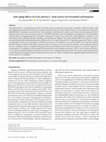
Food Science and Technology, 2021
Anti-aging effect is a stimulating topic that attracting serious consideration from many research... more Anti-aging effect is a stimulating topic that attracting serious consideration from many researchers. Medicinal plants with anti-aging properties thereby have become common research subjects in various fields of science. This study aims to determine phytochemical constituents, specifically the total of phenolic and flavonoid contents and evaluate the anti-aging activity of ethanolic extracts from the stem of Lasia spinosa L. The DPPH and ABTS assays were applied to investigate the in vitro antioxidant and free radical scavenging properties. Drosophila melanogaster CantonS was used as the model organism to evaluate in vivo antioxidant activity, lifespan extension, climbing, and reproduction abilities. The results indicated that Lasia spinosa L. extract presented the phenolic and flavonoid contents, which were 271.65 mg GAE/g and 579.57 mg QE/g, respectively. The EC 50 values of antioxidant activity was 23.80 µg/mL in DPPH assay and was 3.56 µg/mL for the assay of ABTS. The result also showed that the lifespan of adult fruit flies fed on extracts from Lasia spinosa L. was increased in oxidative stress conditions induced by H 2 O 2. In lifespan assays, Drosophila melanogaster fed on the ethanolic extract from Lasia spinosa L. stem at 0.5 mg/mL of concentration in combination with standard food showed their mean lifespan increased to 22.9%, 50% survival increased to 22.2%, and the maximum lifespan of last flies increased to 20.7% compared with the control. The research results demonstrated a potential property among its natural compounds of Lasia spinosa L, which is capable of anti-aging through antioxidant activity in vitro and in vivo conditions.
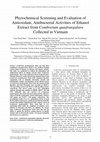
International Journal of Pharma Medicine and Biological Sciences
Combretum quadrangulare Kurz has long been considered a precious herb, which is very useful in tr... more Combretum quadrangulare Kurz has long been considered a precious herb, which is very useful in treating various kinds of diseases on humans and aquatic animals. The study was conducted to evaluate the antioxidant and antibacterial effects of ethanol extracts from Combretum quadrangulare Kurz fruit collected in Kien Giang province, Vietnam. Research results showed that ethanol extract from Combretum quadrangulare Kurz fruit contained bioactive compounds such as alkaloids, flavonoids, steroids and triterpenoids, tannins, and phenolics. In the ethanol extract of Combretum quadrangulare Kurz fruit, the content of total phenolics and total flavonoids were recorded at 230.89 ± 2.36 mg GAE/g extract and 165.35 ± 5.80 mg QE/g extract, respectively. The survey results of in vitro antioxidant capacity through four methods of DPPH, ABTS •+ , RP and TAC indicated that the extracts of Combretum quadrangulare Kurz fruit showed its good activity with EC50 values of 103.90 ± 0.40 µg/mL, 24.18 ± 0.06 µg/mL, 128.58 ± 0.20 µg/mL and 79.30 ± 1.40 µg/mL, respectively. The investigation results of in vivo antioxidant activity on fruit fly Drosophila melanogaster model showed that the fruit flies raised in the medium supplemented with 1 mg/mL extract of Combretum quadrangulare Kurz fruit had in vivo antioxidant effect under the conditions of oxidative stress induced by Paraquat and H2O2. In addition, the extract from Combretum quadrangulare Kurz fruit also had the ability to against the bacteria causing diseases in aquatic animals such as Edwardsiella ictaluri, Aeromonas hydrophila and Streptococcus agalactiae.
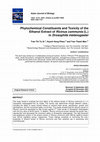
Asian journal of biology, Nov 26, 2021
The study aimed to evaluate the toxic ability of the ethanol extract of Ricinus communis (L.) in ... more The study aimed to evaluate the toxic ability of the ethanol extract of Ricinus communis (L.) in Drosophila melanogaster fruit fly model. The toxicity was determined through different criteria, including the ability to cause harmful effects on second instar larvae, reproduction, growth and development, and the movement ability of fruit flies. The results showed that the ethanol extract of Ricinus communis expressed its high toxicity against 2 nd instar larvae of Drosophila melanogaste with the LD 50 value of 64.63 mg/mL. In addition, Ricinus communis extract reduced the growth rate, reproduction and decreased the movement ability of Drosophila melanogaster. The total flavonoid and polyphenol content of the ethanol extract of Ricinus communis were 338.26 mgQE/g extract and 160.43 mgGAE/g extract, respectively. These findings contribute to confirming the toxic properties of ethanol extract of Ricinus communis and their potential use in preventing and controlling pest.

Rambutan (Nephelium lappaceum L.) brings enormous economic value for Vietnam. It is necessary to ... more Rambutan (Nephelium lappaceum L.) brings enormous economic value for Vietnam. It is necessary to support the basic research to analyze genetic diversity among rambutan cultivars for identification and conservation. The objectives of this study were to analyze the genetic diversity by DNA barcodes and evaluate polymorphism by ISSR markers on eight rambutan cultivars. Fourteen specimens of eight rambutan cultivars collected to detect the differences in their genotype on the matK and ITS region, combined with ISSR technique. matK gene was sequenced on 12 specimens of rambutan and clustered into three groups on the phylogenetic tree. Besides, nine SNP locations have also been recorded in matK gene and five of them could be used to identify three cultivars including yellow-flesh rambutan, Java rambutan, and the hybrid rambutan Tien Cuong. Results of the polymorphism combining ISSR 10 and ISSR 23 primers gave an average of 11 polymorphic bands per primer. In which, six polymorphic bands were recorded to identify the original rambutan, yellow-flesh rambutan and the hybrid rambutan Tien Cuong. As a conclusion, these diverse characters could be potentially applied in rambutan cultivars identification as well as building a DNA database for Vietnamese rambutan.

DNA barcoding employs sequence variation in short, standardized gene regions as a tool to discrim... more DNA barcoding employs sequence variation in short, standardized gene regions as a tool to discriminate species and has many applications in plant authentication. Success amplification through PCR plays a vital role in DNA barcode library construction and sequencing. This study aims to improve determine the optimal annealing temperature for DNA barcode amplification. In this study, eight DNA barcode regions including ITS, matK, rbcL, rpoC1, ycf1b, trnH-psbA, atpF-atpH and psbK-psbI were amplified by gradient PCR to assess and determine the proper annealing temperature. Our results indicated that the PCR yield and specificity for ITS, matK, rbcL, rpoC1 and ycf1b were optimized using gradient PCR. 58°C was required for optimal primer binding temperature in ITS regions while the other regions involved lower annealing temperature, ranging from 49.1°C to 54.2°C. These findings illustrated that an appropriate annealing temperature contributed significantly for PCR success, which is a key step for sequencing quality.

<em>This study aimed to evaluate the antioxidant and antibacterial activities of some plant... more <em>This study aimed to evaluate the antioxidant and antibacterial activities of some plants collected in Kien Giang province, Vietnam. The antioxidant property was determined for their antioxidant activity by DPPH, ABTS●+, RP và TAC methods in vitro. The results showed that the ethanolic extract of Artemisia vulgaris displayed in vitro antioxidant activities with its IC50 (half maximal inhibitory concentration) values of 734.323 µg/mL, 43.871 µg/mL, 185.32 µg/mL and 62.714 µg/mL, respectively. Antioxidant assay identified that, the ethanolic extract of Costus speciosus exhibited DPPH scavenging with IC50 of 1158.24 μg/mL in comparison with the extract of Pouzolzia zeylanica expressing IC50 at an amount of 1034.55 μg/mL. However, antioxidant capacity of Costus speciosus was approximately 2.85 times higher than that of Pouzolzia zeylanica in TAC method. Total phenolic and flavonoid contents of Artemisia vulgaris extract reached the highest at 103.8 mg GAE/g and 287.65 mg QE/g, respectively. These findings concluded that Artemisia vulgaris is a very potential herb containing natural antioxidant compounds.</em>
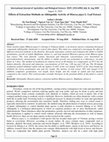
Giant sensitive plant (Mimosa pigra L.) belongs to Fabacae family, is an invasive species contain... more Giant sensitive plant (Mimosa pigra L.) belongs to Fabacae family, is an invasive species containing biological compounds (allelopathic chemicals) to control other plants. This study was conducted to investigate the effect of different extraction methods on the phenolic, flavonoid, mimosinne contents and evaluation the ability to inhibit germination, growth of radish (Raphanus sativus L.) and leaf mustard (Brassica juncea) from Mimosa pigra leaf extract. The total phenolic content, flavonoid and mimosine concentrations were determined by spectrophotometric measurement, and the ability to inhibit growth was performed in a laboratory, on petri dishes in 5 days. The method of incubation for mimosa leaves in 60 minutes at a temperature of 50°C has the highest phenolic, flavonoid and mimosine concentrations of 6.63 mg, 1.86 mg and 1.89 mg. The 60-minute incubation method inhibited radish with the highest 21.44% of the root length, 38.01% of the shoot height but inhibited the lowest germination rate and dry weight. The mixture of leaf extract 10% and vinegar 0.1% inhibited completely germination, root length, shoot height, and the weight of radish and leaf mustard compared to the control. This result provides scientific literature on the potential ability of this plant to control weeds.

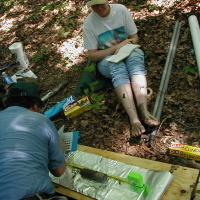






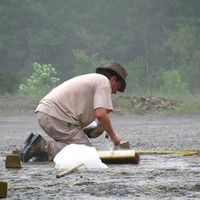

Uploads
Papers by Tran Thanh Men 001974